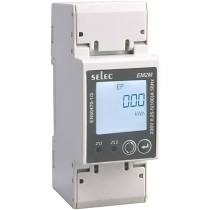Selec Energy Monitor
The selec_meter sensor platform allows you to use Selec Modbus energy monitors
(website)
with ESPHome.

The communication with this component is done via a UART using Modbus.
You must therefore have a uart: entry in your configuration with both the TX and RX pins set
to some pins on your board and the baud rate set to 9600.
# Example configuration entry
uart:
rx_pin: D1
tx_pin: D2
baud_rate: 9600
stop_bits: 1
sensor:
- platform: selec_meter
total_active_energy:
name: "SelecEM2M Total Active Energy"
import_active_energy:
name: "SelecEM2M Import Active Energy"
export_active_energy:
name: "SelecEM2M Export Active Energy"
total_reactive_energy:
name: "SelecEM2M Total Reactive Energy"
import_reactive_energy:
name: "SelecEM2M Import Reactive Energy"
export_reactive_energy:
name: "SelecEM2M Export Reactive Energy"
apparent_energy:
name: "SelecEM2M Apparent Energy"
active_power:
name: "SelecEM2M Active Power"
reactive_power:
name: "SelecEM2M Reactive Power"
apparent_power:
name: "SelecEM2M Apparent Power"
voltage:
name: "SelecEM2M Voltage"
current:
name: "SelecEM2M Current"
power_factor:
name: "SelecEM2M Power Factor"
frequency:
name: "SelecEM2M Frequency"
maximum_demand_active_power:
name: "SelecEM2M Maximum Demand Active Power"
maximum_demand_reactive_power:
name: "SelecEM2M Maximum Demand Reactive Power"
maximum_demand_apparent_power:
name: "SelecEM2M Maximum Demand Apparent Power"Configuration variables
total_active_energy (Optional): Use the total active energy value of the sensor in kilo watt hours. All options from Sensor.
import_active_energy (Optional): Use the import active energy value of the sensor in kilo watt hours. All options from Sensor.
export_active_energy (Optional): Use the export active energy value of the sensor in kilo watt hours. All options from Sensor.
total_reactive_energy (Optional): Use the total reactive energy value of the sensor in kilo volt amps reactive hours. All options from Sensor.
import_reactive_energy (Optional): Use the import reactive energy value of the sensor in kilo volt amps reactive hours. All options from Sensor.
export_reactive_energy (Optional): Use the export reactive energy value of the sensor in kilo volt amps reactive hours. All options from Sensor.
apparent_energy (Optional): Use the apparent energy value of the sensor in kilo volt amps hours. All options from Sensor.
active_power (Optional): Use the (active) power value of the sensor in watts. All options from Sensor.
reactive_power (Optional): Use the reactive power value of the sensor in VAR. All options from Sensor.
apparent_power (Optional): Use the apparent power value of the sensor in VA. All options from Sensor.
voltage (Optional): Use the voltage value of the sensor in volts. All options from Sensor.
current (Optional): Use the current value of the sensor in amperes. All options from Sensor.
power_factor (Optional): Use the power factor value of the sensor. All options from Sensor.
frequency (Optional): Use the frequency value of the sensor in hertz. All options from Sensor.
maximum_demand_active_power (Optional): Use the maximum demand (active) power value of the sensor in watts. All options from Sensor.
maximum_demand_reactive_power (Optional): Use the maximum demand reactive power value of the sensor in VAR. All options from Sensor.
maximum_demand_apparent_power (Optional): Use the maximum demand apparent power value of the sensor in VA. All options from Sensor.
update_interval (Optional, Time): The interval to check the sensor. Defaults to
60s.address (Optional, int): The address of the sensor if multiple sensors are attached to the same UART bus. You will need to set the address of each device manually. Defaults to
1.

